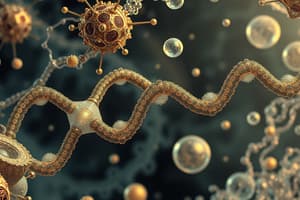Podcast
Questions and Answers
What is the term for the change in free energy of a reaction?
What is the term for the change in free energy of a reaction?
- T∆Srxn
- ∆Grxn (correct)
- ∆Hrxn
- Ea
Catalysts change the overall free energy change, ∆G, of a reaction.
Catalysts change the overall free energy change, ∆G, of a reaction.
False (B)
What is the effect of enzymes on the activation energy of a reaction?
What is the effect of enzymes on the activation energy of a reaction?
Enzymes lower the activation energy.
The systematic name for an enzyme typically begins with _____ and ends with -ase.
The systematic name for an enzyme typically begins with _____ and ends with -ase.
Match the following enzymes with their requirements:
Match the following enzymes with their requirements:
What is the rate law for the reaction A + 2B → C if it is governed by a single elementary step?
What is the rate law for the reaction A + 2B → C if it is governed by a single elementary step?
Enzymes can enhance reaction rates by factors ranging from 10^6 to 10^14.
Enzymes can enhance reaction rates by factors ranging from 10^6 to 10^14.
Define thermodynamically unstable in the context of ATP.
Define thermodynamically unstable in the context of ATP.
What is one role of metal ions in enzymatic catalysis?
What is one role of metal ions in enzymatic catalysis?
Acid-base catalysis involves the transfer of H+ ions.
Acid-base catalysis involves the transfer of H+ ions.
Name the amino acids that are part of the catalytic triad in serine proteases.
Name the amino acids that are part of the catalytic triad in serine proteases.
In acid-base catalysis using RNase, His 12 acts as a ______ and His 119 acts as a ______.
In acid-base catalysis using RNase, His 12 acts as a ______ and His 119 acts as a ______.
Match the following enzymes with their specific action:
Match the following enzymes with their specific action:
What does the Michaelis-Menten equation primarily describe?
What does the Michaelis-Menten equation primarily describe?
Which of the following is not a mechanism of catalysis mentioned?
Which of the following is not a mechanism of catalysis mentioned?
The Michaelis constant (KM) is independent of the binding affinity of the enzyme for its substrate.
The Michaelis constant (KM) is independent of the binding affinity of the enzyme for its substrate.
The act of transiently forming a covalent bond during a reaction is called ______ catalysis.
The act of transiently forming a covalent bond during a reaction is called ______ catalysis.
The preferential stabilization of the transition state is a characteristic of electrostatic catalysis.
The preferential stabilization of the transition state is a characteristic of electrostatic catalysis.
What is the significance of kcat in enzyme kinetics?
What is the significance of kcat in enzyme kinetics?
At steady state, the rate of formation of ES is equal to the rate of __________.
At steady state, the rate of formation of ES is equal to the rate of __________.
Match the following terms with their definitions:
Match the following terms with their definitions:
What represents the efficiency of an enzyme?
What represents the efficiency of an enzyme?
In the Michaelis-Menten model, the ES complex is assumed to be in a steady state.
In the Michaelis-Menten model, the ES complex is assumed to be in a steady state.
What does the rate equation v0 = Vmax[S]/(KM + [S]) indicate about substrate concentration?
What does the rate equation v0 = Vmax[S]/(KM + [S]) indicate about substrate concentration?
Flashcards
Change in Free Energy (ΔG)
Change in Free Energy (ΔG)
The change in free energy during a reaction, indicating whether it's spontaneous or not. Negative delta G indicates a spontaneous reaction.
Free Energy
Free Energy
Energy available to do work as a reaction reaches equilibrium.
Thermodynamically Unstable
Thermodynamically Unstable
A molecule like ATP that is thermodynamically unstable but kinetically stable, meaning it has a high potential energy for release but doesn't readily break down.
Activation Energy (Ea or ΔG++)
Activation Energy (Ea or ΔG++)
Signup and view all the flashcards
Catalyst
Catalyst
Signup and view all the flashcards
Enzymes
Enzymes
Signup and view all the flashcards
Reaction Rate
Reaction Rate
Signup and view all the flashcards
Rate Law
Rate Law
Signup and view all the flashcards
Enzyme Catalysis
Enzyme Catalysis
Signup and view all the flashcards
Acid-Base Catalysis
Acid-Base Catalysis
Signup and view all the flashcards
Covalent Catalysis
Covalent Catalysis
Signup and view all the flashcards
Metal Ion Catalysis
Metal Ion Catalysis
Signup and view all the flashcards
Electrostatic Catalysis
Electrostatic Catalysis
Signup and view all the flashcards
Schiff Base Formation
Schiff Base Formation
Signup and view all the flashcards
Serine Proteases
Serine Proteases
Signup and view all the flashcards
Transition State Analog
Transition State Analog
Signup and view all the flashcards
Why Study Enzyme Kinetics?
Why Study Enzyme Kinetics?
Signup and view all the flashcards
Michaelis-Menten Equation
Michaelis-Menten Equation
Signup and view all the flashcards
What is KM?
What is KM?
Signup and view all the flashcards
What is Kcat?
What is Kcat?
Signup and view all the flashcards
What is the specificity constant?
What is the specificity constant?
Signup and view all the flashcards
Study Notes
Enzymes
- Enzymes are proteins that catalyze biochemical reactions.
- Enzymes lower the activation energy for both forward and reverse reactions.
- Enzymes do not change the overall free energy (ΔG) change of a reaction.
Rate vs Direction of Biochemical Reactions
- Free energy is the energy available to do work as a reaction approaches equilibrium.
- ΔGrxn = ΔΗrxn - TAS
- ΔGrxn < 0 for spontaneous reactions.
- ATP is thermodynamically unstable but kinetically stable. This is shown in a free energy diagram for ATP hydrolysis. ΔG° = -30.5 kJ/mol.
Biochemical Kinetics
- Rate = k [A][B]2, where k is the rate constant.
- Rate constant, k, is defined by the Arrhenius equation and includes the temperature and activation energy (Ea = ΔG++).
- Ea = Ae-Ea/RT, where A is the frequency factor, R is the gas constant, and T is the Kelvin temperature.
Catalysts
- Catalysts increase the rate of reactions toward equilibrium by lowering ΔG++.
- Enzymes can provide enhancements of 106 to 1014 in reaction rates.
Enzyme Classification
- Oxidoreductases: catalyze oxidation-reduction reactions.
- Transferases: transfer functional groups.
- Hydrolases: catalyze hydrolysis reactions.
- Lyases: catalyze group elimination to form double bonds.
- Isomerases: catalyze isomerization reactions.
- Ligases: catalyze bond formation coupled with ATP hydrolysis.
Enzyme Nomenclature
- Enzymes usually end in "-ase."
- Common names are often ambiguous; systematic names are established by the enzyme commission of IUBMB (e.g., carboxypeptidase A, systematic name: peptidyl-L-amino acid hydrolase EC.3.4.17.1).
How do enzymes lower ΔG‡?
- Binding and orientation of substrate(s) to increase reactivity and proximity of chemical groups.
- Preferential binding of X+.
- Provide an alternative pathway with a lower ΔG‡.
Chemical Bases for Enzymatic Catalysis
- Acid-base catalysis (H+ transfer)
- Covalent catalysis (transient covalent bond)
- Metal ion catalysis
- Transition metal ions in active site play a role in catalysis (Fe, Cu, Zn, Mn, Co).
- Contributions to electrostatic catalysis.
- Increase reactivity of H2O by polarization.
- Redox reactions.
- Electrostatic effects (stabilization of X+, binding, and orientation of substrate S)
- Electron transfer (redox)
- Polarization of H2O (e.g., carbonic anhydrase)
- Charge-shielding on substrate (e.g., Mg-ATP).
Specific Example: RNase
- Two key histidine residues in the active site: His 12 (base) and His 119 (acid).
- An example of a hydrolysis reaction.
Enzyme Kinetics
- Michaelis-Menten Equation describes the reaction rate of non-allosteric enzymes
- Rate equation: v = Vmax[S]/ (KM + [S])
- Vmax = maximum velocity
- KM= (k-1 + k2)/ k1 or rate of dissociation of ES
Significance of KM
- KM is the substrate concentration at which the reaction rate is half-maximal (Vmax/2)
- related to the equilibrium binding affinity of E for S
Catalytic Constant, kcat
- kcat is a first-order rate constant that represents the maximum rate of a substrate turnover in an enzyme catalyzed reaction.
- kcat = Vmax/ET , (where ET is the total enzyme concentration)
Specificity Constant, kcat/KM
- A measure of catalytic efficiency. A higher rate generally means better efficiency
Two-Substrate Reactions
- Sequential mechanism
- Both substrates bind to the enzyme, producing a ternary complex, before any product is formed.
- Ping-pong mechanism
- One substrate binds, then the first product is released before the second substrate binds.
Allosteric Enzymes
- Multi-subunit proteins (multiple catalytic and regulatory subunits).
- Subunit interactions stabilize low-affinity (T) state.
- Allosteric effectors (modulators) can be positive or negative.
- Substrate binding can show positive cooperativity.
Example: Aspartate Transcarbamoylase
- First step in pyrimidine biosynthesis.
- Complex of six catalytic and six regulatory subunits (C6R6).
- Allosteric effectors: substrates (+), CTP (-), ATP (+).
Covalent Modifications
- Phosphorylation, adenylation, acetylation, myristoylation are common covalent modifications that produce allosteric-like changes.
Regulation of Enzyme Activities
- Rapid: noncovalent modification (competitive inhibition, substrate/effector binding).
- Slower: covalent modifications (phosphorylation), degradation and synthesis of mRNA/polypeptides.
Enzyme Inhibition
- Irreversible inhibitors: inactivators (typically very reactive electrophiles)
- Reversible inhibitors: bind noncovalently and reversibly.
Different types of Enzyme Inhibition
- Competitive Inhibition
- Uncompetitive Inhibition
- Mixed Inhibition
- Noncompetitive Inhibition
Studying That Suits You
Use AI to generate personalized quizzes and flashcards to suit your learning preferences.




